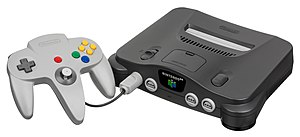N64
 |
|

A charcoal grey Nintendo 64 console and grey controller
|
|
| Also known as | Project Reality (code name), Ultra 64 (planned product name) |
|---|---|
| Developer | Nintendo IRD |
| Manufacturer | Nintendo |
| Type | Home video game console |
| Generation | Fifth generation |
| Release date | |
| Retail availability | 1996–2003 |
| Discontinued | |
| Units shipped |
Worldwide: 32.93 million Japan: 5.54 million Americas: 20.63 million Europe & Australia: 6.75 million |
| Media |
Nintendo 64 Game Pak Magnetic disc (64DD) |
| CPU | 64-bit NEC VR4300 @ 93.75 MHz |
| Memory | 4 MB Rambus RDRAM (8 MB with Expansion Pak) |
| Storage | 64 MB Game Pak |
| Removable storage | 256 Kbit (32 KB) Controller Pak |
| Graphics | SGI RCP @ 62.5 MHz |
| Sound | 16 bit, 48 or 44.1 kHz Stereo |
| Controller input | Nintendo 64 controller |
| Power | Switching power supply, 12V and 3.3V DC |
| Online services |
Randnet (Japan only) SharkWire Online (third-party) |
| Best-selling game | Super Mario 64, 11.62 million (as of May 21, 2003) |
| Predecessor | Super NES |
| Successor | GameCube |
| Related articles | Nintendo 64 technical specifications, 64DD, Game Pak, Rumble Pak, games, accessories, color variants, programming characteristics |
| Website | www |
The Nintendo 64 (Japanese: ニンテンドウ64 Hepburn: Nintendō Rokujūyon?), stylized as NINTENDO64 and often referred to as N64, is Nintendo's third home video game console for the international market. Named for its 64-bit central processing unit, it was released in June 1996 in Japan, September 1996 in North America, March 1997 in Europe and Australia, September 1997 in France and December 1997 in Brazil. It is the industry's last major successive home console to use the cartridge as its primary storage format, as all succeeding home consoles up until the Nintendo Switch used an optical format. In addition, current handheld systems (such as the PlayStation Vita and Nintendo 3DS) also use cartridges. While the Nintendo 64 was succeeded by Nintendo's MiniDVD-based GameCube in November 2001, the consoles remained available until the system was retired in late 2003.
Code-named Project Reality, the console's design was mostly finalized by mid-1995, though Nintendo 64's launch was delayed until 1996. As part of the fifth generation of gaming, the system competed primarily with the PlayStation and the Sega Saturn. The Nintendo 64 was launched with three games: Super Mario 64 and Pilotwings 64, released worldwide; and Saikyō Habu Shōgi, released only in Japan. The Nintendo 64's suggested retail price at its United States launch was US$199.99 and it was later marketed with the slogan "Get N, or get Out!". With 32.93 million units worldwide, the console was ultimately released in a range of different colors and designs, and an assortment of limited-edition controllers were sold or used as contest prizes during the system's lifespan. IGN named it the 9th greatest video game console of all time; and in 1996, Time magazine named it Machine of the Year. As of 2016, the system remains a popular retro system in North America.
...
Wikipedia
